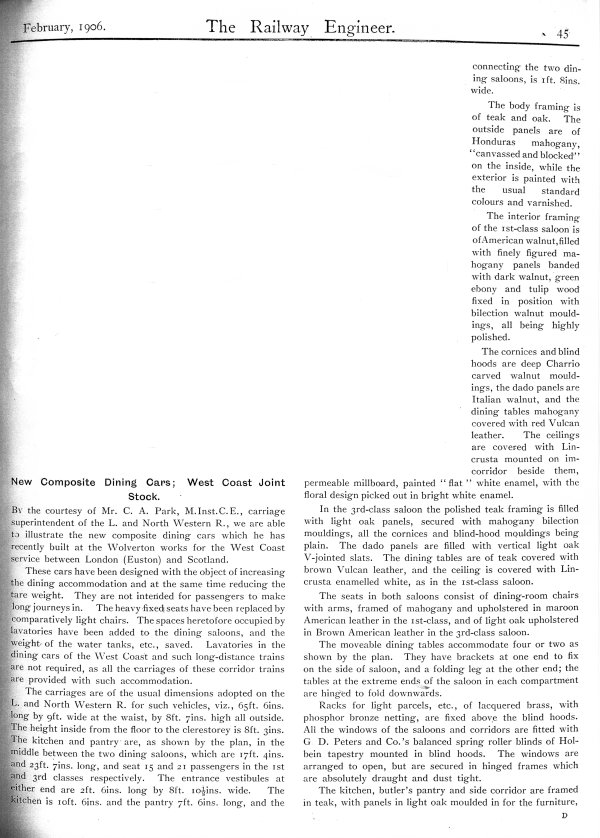
p45
Transcription:
By the courtesy of Mr C A Park, M Inst C E, carriage superintendent of the L and North Western R, we are able to illustrate the new composite dining cars which he has recently built at the Wolverton works for the West Coast service between London (Euston) and Scotland.
These cars have been designed with the object of increasing the dining accomodation and at the same time reducing the tare weight. They are not intended for passengers to make long journeys in. The heavy fixed seats have been replaced by comparatively light chairs. The spaces heretofore occupied by lavatories have been added to the dining saloon, and the weight of the water tanks, etc., saved. Lavatories in the dining cars of the West Coast and such long-distance trains are not required, as all the carriages of these corridor trains are provided with such accommodation.
The carriages are of the usual dimensions adopted on the L and North Western R for such vehicles, viz., 65 ft 6 ins long by 9 ft wide at the waist, by 8 ft 7 ins high all outside. The height inside from the floor to the clerestorey is 8 ft 3 ins. The kitchen and pantry are, as shown by the plan, in the middle between the two dining saloons, which are 17 ft 4 ins and 23 ft 7 ins long, and seat 15 and 21 pssengers in the 1st ans 3rd classes respectively. The entrance vestibules at either end are 2 ft 6 ins long by 8 ft 10½ ins wide. The kitchen id 10 ft 6 ins and the pantry 7 ft 6 ins long, and the connecting the two dining saloons, is 1 ft 8 ins wide.
The body framing is of teak and oak. The outside panels are of Honduras mahogany, “canvassed and blocked” on the inside, while the exterior is painted with the usual standard colours and varnished.
The interior framing of the 1st-class saloon is of American walnut, filled with finely figured mahogany panels banded with dark walnut, green ebony and tulip wood fixed in position with bilection walnut mouldings, all being highly polished.
The cornices and blind hoods are deep Charrio carved walnut mouldings, the dado panels are Italian walnut, and the dining tables mahogany covered with red Vulcan leather. The ceilings are covered with Lincrusta mounted on imcorridor beside them, permeable millboard, painted “flat” white enamel, with the floral design picked out in bright white enamel.
In the 3rd-class saloon the polished teak framing is filled with light oak panels, secured with mahogany bilection mouldings, all the cornices and blind-hood mouldings being plain. The dado panels are filled with vertical light oak V-jointed slats. The dining tables are of teak covered with brown Vulcan leather, and the ceiling is covered with Lincrusta enamelled white, as in the 1st-class sloon.
The seats in both saloons consist of dining-room chairs with arms, framed of mahogany and upholstered in maroon American leather in the 1st-class, and of light oak upholstered in Brown American leather in the 3rd-class saloon.
The moveable dining tables accomodate four or two as shown by the plan. They have brackets at one end to fix on the side of saloon, and a folding leg at the other end; the tables at the extreme ends of the saloon in each compartment are hinged to fold downwards.
Racks for light parcels, etc., of lacquered brass, with phosphor bronze netting, are fixed above the blind hoods. All the windows of the saloons and corridors are fitted with G D Peters and Co’s balanced spring roller blinds of Holbein tapestry mounted in blind hoods. The windows are arranged to open, but are secured in hinged frames which are absolutely draught and dust tight.
The kitchen, butler’s pantry and side corridor are framed in teak, with panels in light oak moulded in for the furniture,